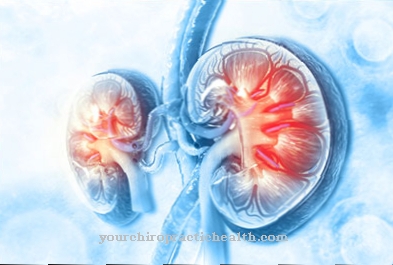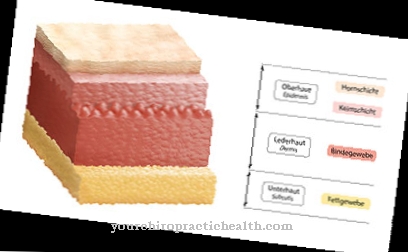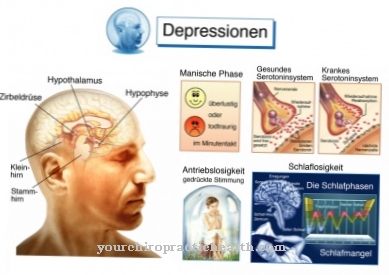From Sleep apnea one speaks when breathing stops during nightly sleep. Therefore one can also from one Sleep apnea syndrome speaking, which causes narrowing of the upper airway. In addition, the cause can also be a malfunction or disorder of the respiratory muscles. Sometimes other diseases (e.g. heart failure) are also responsible for sleep apnea.
What is sleep apnea?

The Sleep apnea is characterized by breathing stops (apneas) lasting more than ten seconds during sleep. The number of apneas per hour determines the severity of the disease. Due to a short-term lack of oxygen, these respiratory arrests often lead to unnoticed wake-up reactions that interrupt night sleep. A restful sleep is no longer possible.
In Germany, up to four percent of the population is affected. Men are more likely to suffer from sleep apnea. Classic symptoms are massive snoring, headaches, dizziness, dry mouth and pronounced daytime sleepiness. The latter leads to a significantly reduced performance, microsleep can occur.
The chronic stress can lead to depression, high blood pressure with the risk of heart attacks or strokes and erectile dysfunction. The diagnosis is made by taking anamnesis and by monitoring in the sleep laboratory.
causes
Here, it is initially more obstructive between central and peripheral Sleep apnea distinguished. The obstructive form is much more common. The throat muscles relax during sleep. When you breathe in, part of the windpipe collapses and obstructs the airway. If the airway does not completely collapse, it is weakened (so-called hypopnea).
Obstructive sleep apnea syndrome is favored by being overweight, impaired nasal breathing (polyps in children, tumors or deformities) and drugs (alcohol, nicotine, sleeping pills). But a predisposition to slack throat muscles can also be a trigger. The central form arises from damage (e.g. morphine intoxication) or diseases (e.g. borreliosis) of the CNS. The result is disturbed breathing regulation in the brain. Central sleep apnea is usually hereditary.
Symptoms, ailments & signs
A common symptom of sleep apnea is excessive daytime sleepiness. This can occur even though an adequate amount of night sleep has been recorded. After sleeping in a shared bedroom, life partners often report irregular loud snoring noises. The cessation of breathing causes the body to alarm due to the reduced oxygen content of the blood.
The blood pressure rises and the breathing muscles are activated. Cardiac arrhythmias can also occur. A sudden, brief waking is possible. Those affected feel like they are bruised in the morning. You are already yawning at the breakfast table and appear energetic. The poor quality of sleep due to the stressful influences of numerous pauses in breathing can significantly reduce the ability to concentrate and perform.
The so-called microsleep at the wheel is a great danger. In addition, the chronic sleep deficit can lead to headaches or depressive moods every day. Anxiety can also occur. Erectile dysfunction and a reduced feeling of sexual pleasure are also possible symptoms of sleep apnea.
A decrease in memory performance and dry mouth are also possible signs. The lack of nocturnal rest can also be expressed by irritability. The oppressive feeling of drowsiness and sleepiness persists throughout the day. Sudden attacks of dizziness can also be signs of sleep apnea. Symptoms also include morning sore throats and heartburn due to the intense mouth breathing.
Complications
Cardiovascular diseases are among the most common complications of sleep apnea: Many people affected suffer from high blood pressure, which is difficult to influence positively with medication. Cardiac arrhythmias can also occur; in the long term, the disease promotes the development of coronary artery disease. The low oxygen content of the blood causes the blood to thicken, so patients with sleep apnea are at an increased risk of suffering a stroke or heart attack.
A disproportionate number of those affected die from sudden cardiac death. Another complication to be mentioned is diabetes mellitus, which in sleep apnea sufferers is often associated with a lipid metabolism disorder and in many cases does not respond well to drug treatment. During operations, there are more incidents than usual that require the intervention to be discontinued: The reason for this can be acute lung failure, a pulmonary embolism or a blood pressure derailment.
Problems also occur more often during follow-up that lead to a long hospital stay. In everyday life, sleep apnea manifests itself in severe tiredness and concentration disorders, and those affected are no longer able to cope with their professional tasks. In many cases, the tendency to microsleep makes it impossible for those affected to drive a motor vehicle or use machines. Constant tiredness and loss of performance can trigger depression. If left untreated, sleep apnea can reduce life expectancy by up to ten years.
When should you go to the doctor?
Symptoms such as difficulty sleeping through the night and headache, dry mouth, or dizziness after getting up can indicate sleep apnea. The family doctor must be consulted if these symptoms appear several nights a week and severely affect well-being. If there are additional symptoms such as heavy night sweats or a tendency to fall asleep during the day, an immediate doctor's visit is recommended. The obstructive sleep apnea syndrome is favored by obesity and an increased age. The use of sedatives or sleeping pills is also one of the risk factors and should be clarified quickly.
Central sleep apnea is triggered by neurological diseases, but can also occur after a tick bite and the resulting Lyme disease. A stroke also increases the suffering. If the symptoms mentioned occur in connection with the risk factors, a doctor or a sleep laboratory should be consulted. The actual treatment usually takes place in a specialist clinic. The family doctor can prescribe the prescribed medication and, if necessary, also carry out regular follow-up checks after the diagnosis.
Treatment & Therapy
The most effective treatment at Sleep apnea is - after reducing the risk factors - CPAP ventilation (CPAP: Continuous Positive Airway Pressure). This is done using a respiratory mask for the mouth or nose. Recently, a nasal cannula can also be used. The ventilation mode is set so that a permanent positive pressure (overpressure of approx. 5 to 20 millibars) is maintained.
This can prevent the throat muscles from collapsing ("internal splint"). This can also prevent snoring. Even if the masks seem frightening at first, users are little affected. It gets used to it quickly and the quality of life is immediately increased.
If this type of ventilation is not possible, BIPAP ventilation can be used (BIPAP: Biphasic Positive Airway Pressure). In contrast to CPAP ventilation, this usually has to be carried out continuously at night. If ventilation is refused by the patient, a so-called protrusion splint can be inserted into the mouth, which prevents the airways from collapsing. A supply with a nasopharyngeal stent has a very similar principle of action.
Modafinil (drug for narcolepsy therapy) can be used to reduce daytime sleepiness. In milder cases, treatment with theophylline (classic indication for asthma and COPD), which has central stimulating effects, is possible.
If the conservative therapies are not sufficient or if the patient would like a causal therapy, surgical intervention can be made. In bimaxillary surgery, the pharynx is surgically enlarged. The results are good. In addition, electricity can "burn" tissue in the pharynx. The scarred shrinkage increases the space behind the tongue.
You can find your medication here
➔ Medication for sleep disordersprevention
One of the most important measures to combat sleep apnea is weight loss. A normal weight should be the goal. Alcohol and nicotine should be avoided or consumption should be restricted. Sleeping pills should also be used sparingly. It has been shown that playing wind instruments has a protective effect. This is explained by the fact that the throat muscles are strengthened by blowing.
Aftercare
The diagnosis of sleep apnea normally requires lifelong use of the prescribed respiratory therapy device, which is why continuous follow-up care is essential for a sustainable lifestyle. The aftercare routines estimated for this can vary depending on the service provider, but they are usually carried out annually. With the help of special measuring devices, which the patient can borrow to take home for one night, all vital values are recorded during sleep.
These include, for example, pulse measurements, the duration of individual sleep phases and the oxygen saturation in the blood. The evaluation takes place on the following day at the attending physician. The patient's sleeping habits may change over the years, so that adjustments to the breathing apparatus may have to be made.
It is also possible that the needs of the patient change over time. For example, it can happen that the air you breathe is perceived as too dry. The prescription of an additional device, which humidifies and warms the breathing air with water, can provide relief in this case.
With daily use of the breathing mask, natural signs of wear and tear are inevitable. A call to the responsible service provider is sufficient to ensure the delivery of new filters, breathing tube, breathing mask and other small parts.
You can do that yourself
Patients who suffer from sleep apnea have numerous opportunities to help themselves in everyday life. These options can both help prevent sleep apnea from occurring in the first place or combat the symptoms.
It is easy and effective to change the sleeping position so that the supine position is avoided. This has already helped many patients. In overweight patients, weight loss is an important building block on the way to restful and healthy sleep. Sport plays a twofold important role: On the one hand, regular exercise helps to shed excess pounds. On the other hand, physical activity supports the fight against sleep apnea effectively.
It is also obvious to refrain from nicotine. Smoking directly and negatively affects breathing. Sleep apnea patients should therefore quit smoking in general, also with a view to their health. It looks less drastic with alcohol. A complete renunciation is not absolutely necessary here, but moderation is the order of the day. It is recommended to stop drinking alcohol four hours before going to sleep and avoid excessive consumption of alcoholic beverages altogether.
In addition, all recommendations apply to sleep apnea patients that otherwise apply to healthy sleep. This includes a not too high temperature in the bedroom, a good mattress or adequate ventilation in the bedroom.




.jpg)






















